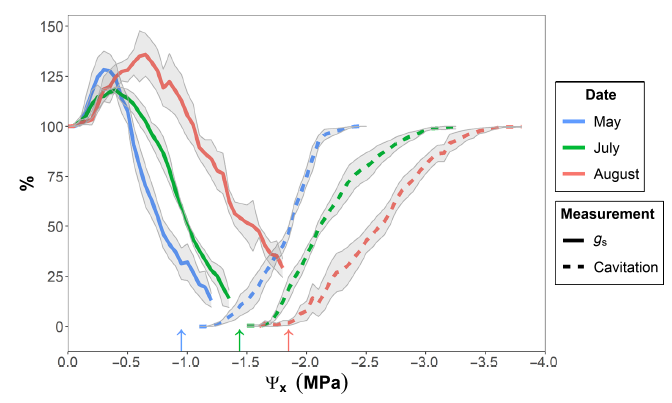Although xylem embolism resistance is traditionally considered as static, we hypothesized
that in grapevine (Vitis vinifera) leaf xylem becomes more embolism-resistant over the growing
season.
We evaluated xylem architecture, turgor loss point (ΨTLP) and water potentials leading to
25% of maximal stomatal conductance (gs25) or 50% embolism in the leaf xylem (P50) in
three irrigation treatments and at three time points during the growing season, while separating
the effects of leaf age and time of season.
Hydraulic traits acclimated over the growing season in a coordinated manner. Without irrigation,
ΨTLP, gs25, and P50 decreased between late May and late August by 0.95, 0.77 and
0.71 MPa, respectively. A seasonal shift in P50 occurred even in mature leaves, while irrigation
had only a mild effect (< 0.2 MPa) on P50. Vessel size and pit membrane thickness were also
seasonally dynamic, providing a plausible explanation for the shift in P50.
Our findings provide clear evidence that grapevines can modify their hydraulic traits along
a growing season to allow lower xylem water potential, without compromising gas exchange,
leaf turgor or xylem integrity. Seasonal changes should be considered when modeling ecosystem
vulnerability to drought or comparing datasets acquired at different phenological stages.

An increase in xylem embolism resistance of grapevine leaves during the growing season is coordinated with stomatal regulation, turgor loss point and intervessel pit membranes
Download Article
Sorek, Y., Grinshtein, S., Netzer, Y., Shtein, I., Jansen, S., & Hochberg, U. (2020). An increase in xylem embolism resistance of grapevine leaves during the growing season is coordinated with stomatal regulation, turgor loss point, and intervessel pit membranes. New Phytologist. https://doi.org/10.1111/nph.17025

